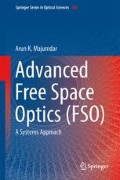Abstract
The process of modulation consists of mapping the information onto magnetic medium (a carrier). There are mainly three parameters of the carrier which can be varied to perform the modulation process for mapping the information into changes in either the amplitude, phase, or frequency of the carrier. The result of this modulation process is amplitude, phase, and frequency modulations, respectively. Demodulation is the reverse process of removing the carrier signal to obtain the original signal waveform (and thus the message/information) back.
Access this chapter
Tax calculation will be finalised at checkout
Purchases are for personal use only
References
X. Fuquin, Digital Modulation Techniques (Artech House, Boston, 2000)
B.E.A. Saleh, M.C. Teich, Fundamentals of Photonics (Wiley, New York, 1991)
H.A. Haus, Electromagnetic Noise and Quantum Optical Measurements (Springer-Verlag, Berlin, 2000)
M.A. Al-Habash, L.C. Andrews, R.L. Phillips, Mathematical model for the irradiance probability density function of a laser beam propagating through turbulent media. Opt. Eng. 40, 1544–1562 (2001)
D.O. Caplan, Laser communication transmitter and receiver design, in Free-space Laser Communications: Principles and Advances, ed. by A.K. Majumdar, J.C. Ricklin (Springer, New York, 2008), pp. 109–246
A.K. Majumdar, Free-space laser communication performance in the atmospheric channel, in Free-Space Laser Communication: Principles and Advances, ed. by A.K. Majumdar, J. C. Ricklin (Springer, New York, 2008)
A.K. Majumdar, W.C. Brown, Atmospheric turbulence effects on the performance of multi-gigabit downlink ppm laser communications. Proc. SPIE 1218, 568–584. (1990) (Free-space laser communication technologies II)
T. Ohtsuki, Multiple-subcarrier modulation in optical wireless communications, IEEE Commun. Mag. 3, 74–79 (2003)
O.P. Wasiu, Thesis Ph.D, University of Northumbria at Newcastle, September 2009
L.C. Andrews, R.L. Phillips, Laser Beam Propagation through Random Media (SPIE Optical Engineering, Bellingham, 2005)
W. Hanling, Y. Haixing, L. Xinyang, Performance analysis a bit error rate for free space optical communication with tip-tilt compensation based on gamma-gamma distribution. Opt Appl. 39(3), 533–545 (2009)
A.A. Farid, S. Hranilovic, Link reliability range and rate optimization for free-space optical channels, conTEL 2009. 10th International conference on Telecommunications Zagreb, Croatia, 2009, pp. 19–23
Y.I. Xiang, L.I.R. Zengji, Y.U.E. Peng, S. Tao, BER Performance Analysis for M-ary PPM over Gamma-Gamma atmospheric turbulence channels, in Wireless Communications Networking and Mobile Computing (WiCOM), ISBN: 978-1-4244-3709, IEEE Conference, 23–25 Sept 2010
The Wolfram function site, 1998–2014 Wolfram Research, Inc. http://functions.Wolfram.com
J. Li, J.Q. Liu, D.P. Taylor, Optical communication using subcarrier PSK intensity modulation through atmospheric turbulence channels. IEEE Trans. Commun. 55(8), 1598–1606 (2007)
L.C. Andrews, R.L. Phillips, Y.C. Hopen, Laser Beam Scintillation with Application (SPIE, Bellingham, 2001)
W.O. Popoola, Z. Ghassemlooy, BPSK Subcarrier Intensity Modulated Free-Space Optical Communications in Atmospheric Turbulence. J. Lightwave Technol. 27(8), 967–973 (2009)
W.O. Popoola, Z. Ghassemlooy, E. Leitgeb, Free-space optical communication using subcarrier modulation in gamma-gamma atmospheric turbulence, in 9th International conference on Transparent optical Networks (ICTON’07), Rome. Italy 3, 2007, pp. 156–160
H. Simon, Digital Communications (Wiley, New York, 1988)
S.Klar Bernard, Digital Communications: Fundamentals and Applications (PTR Prentice Hall, New Jersey, 1988)
S. Bendetto, R. Gaudino, P. Poggiolini, Direct detection of optical digital transmission based on polarization shift keying modulation. IEEE Sel. Areas Commun. 13, 531–542 (1995)
J.A. Anguita, I.B. Djordjevic, M.A. Neifeld, B.V. Vasic, Shannon capacities and error-correction codes for optical atmospheric turbulent channels. J Opt. Netw. 4(9), 586–601 (2005)
S.G. Lambert, W.L. Casey, Laser Communications in Space (Artech House, Boston, 1995)
I.S. Reed, G. Solomon, Polynomial codes over certain finite fields. J Soc. Ind. Appl. Math. 8, 300–304 (1960)
I.B. Djordjevic, W. Ryan, B. Vasic, Coding for Optical Channels (Springer-Verlag, New York, 2010)
M. Mansour, Implementation of LDPC decoders, presented at the IEEE communication Theory Workshop, Park City, Utah, 13–15 June 2005
C. Berrou, A. Glavieux, Near optimum error connecting coding and decoding: Turbo-codes. IEEE Trans. Commun. 44, 1261–1271, (1996)
X. Fang, K. Ali, C. Patrice, B. Salah, Channel coding and time-diversity for optical wireless links. Opt. Express. 17(2), 872–887 (2009)
Z. Xiaoming, M.Kahn Joseph, Communication techniques and coding for atmospheric turbulence channels, in Free-Space Laser Communications: Principles and Advances, ed. by A.K. Majumdar, J.C. Ricklin (Springer, Berlin, 2008), pp. 303–345
Z. Wang, W.-D. Zhong, S. Fu, C. Lin, Performance comparison of different modulation formats over free-space optical (FSO) turbulence links with space diversity reception technique, IEEE Photonics J. 1(6), 277–285 (2009)
E. Hu, K. Wong, M. Marhic, L.G. Kazovsky, K. Shimizu, N. Nikuchi, 4-level Direct-Detection Polarization Shift-Keying (DD-PolSK) system with Phase Modulators, in optical Fiber Conference (OFC), 2003
T.M. cover, J.A. Thomas, Elements of Information Theory (Wiley-Interscience, New Jersey, 1991)
A. Papoulis, Probability Random Variables, Chapter 6 Two Random Variables and Stotachastic Processes (WCB/McGraw Hill, 1991)
Author information
Authors and Affiliations
Rights and permissions
Copyright information
© 2015 Springer Science+Business Media New York
About this chapter
Cite this chapter
Majumdar, A. (2015). Modulation, Detection, and Coding for Free-space Optical (FSO) Communications. In: Advanced Free Space Optics (FSO). Springer Series in Optical Sciences, vol 186. Springer, New York, NY. https://doi.org/10.1007/978-1-4939-0918-6_3
Download citation
DOI: https://doi.org/10.1007/978-1-4939-0918-6_3
Published:
Publisher Name: Springer, New York, NY
Print ISBN: 978-1-4939-0917-9
Online ISBN: 978-1-4939-0918-6
eBook Packages: Physics and AstronomyPhysics and Astronomy (R0)

